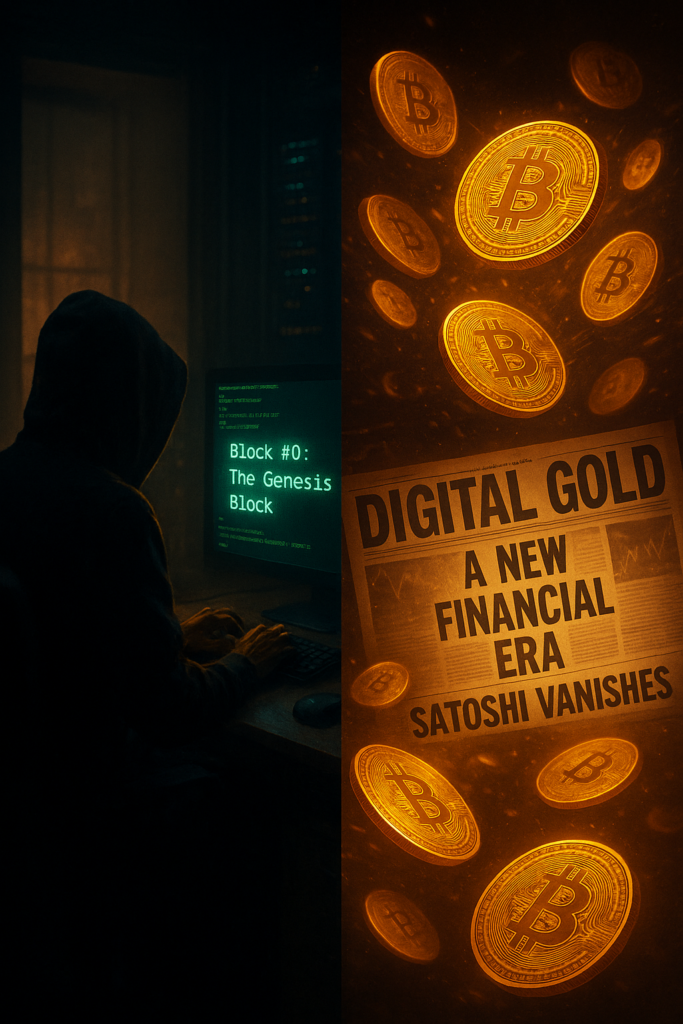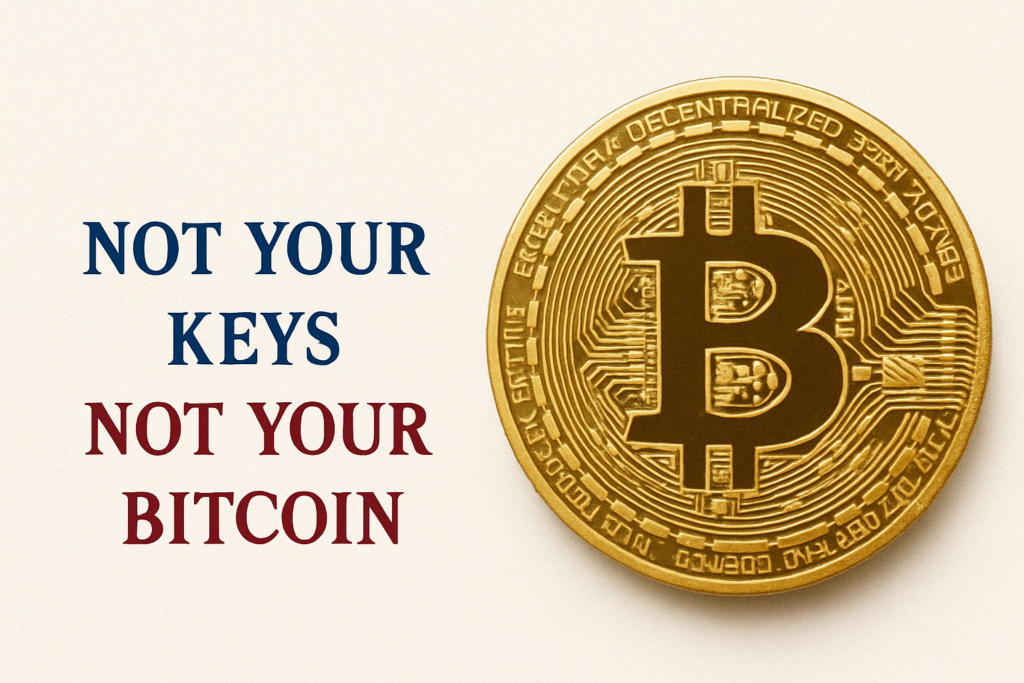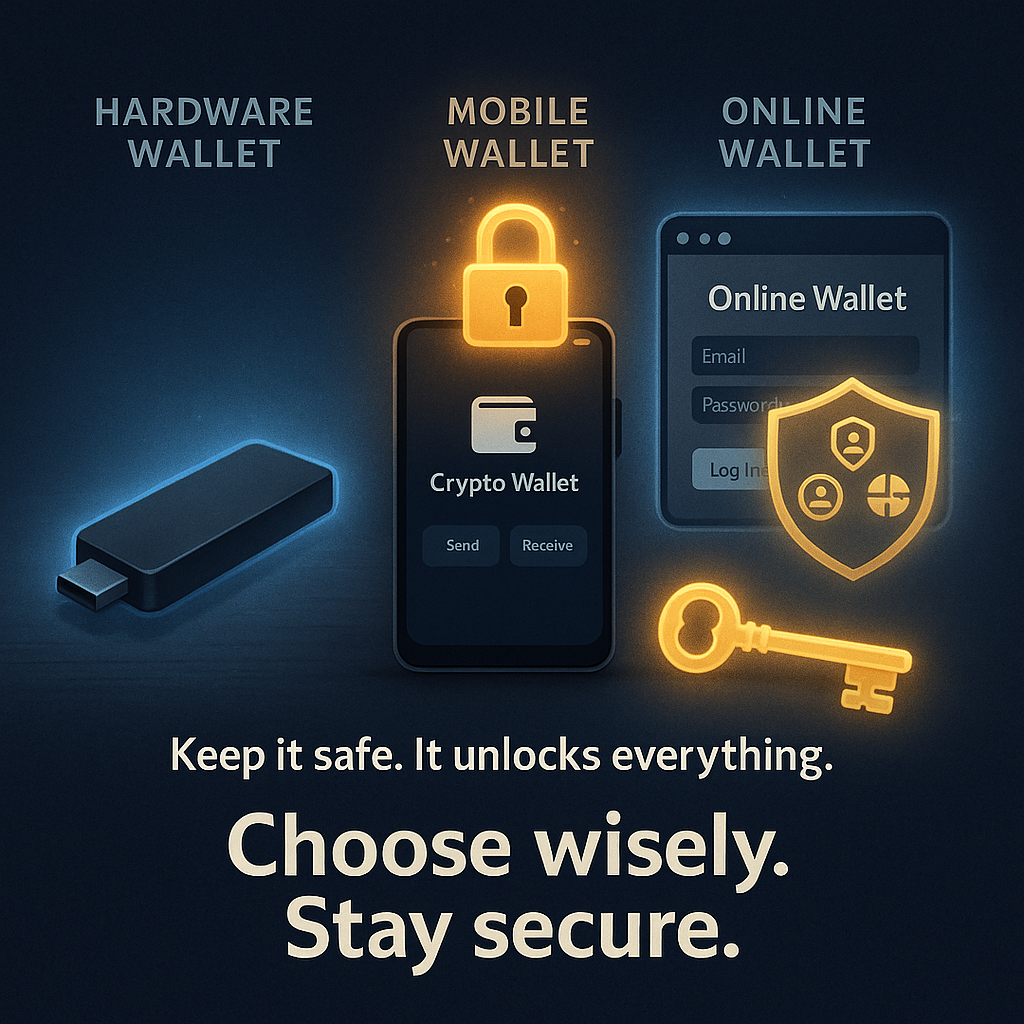Introduction to Bitcoin: The Digital Gold
Brief history and conception of Bitcoin
In the tumultuous year of 2008, amidst a worldwide financial crisis, an anonymous figure named Satoshi Nakamoto introduced something extraordinary to the world: Bitcoin. When he published his white paper titled “Bitcoin: A Peer-to-Peer Electronic Cash System,” Satoshi proposed a radical idea: a digital currency that could operate independently of any central authority.

It was bold and clever and sparked a new wave of innovation and debate. Bitcoin officially came into existence in January 2009 when Satoshi mined the first block, called the ‘Genesis Block.’
Nakamoto vanished from public view in 2010, but his invention continued to grow exponentially.
Today, Bitcoin is regarded not just as another digital currency but as ‘digital gold,’ symbolizing its perceived value and potential.
Understanding the basics: What is Bitcoin?
At its core, Bitcoin is a digital currency: a medium for transactions just like your regular dollars or euros. But these are not coins or notes you can hold in your hand or stash away inside your wallet.
Ultimately, Bitcoin is far more than just a digital currency. Yes, you can use it like dollars or euros, but that’s just the surface. Bitcoin is a protocol, a network, and a radically new way of securing value and trust without needing a central authority.
There are no physical coins or notes to hold—only cryptographic keys, decentralized consensus, and a public ledger open to all. It’s money, yes—but it’s also a movement.

These are pieces of code born out of complex algorithms handled by powerful computers grinding away at mathematical problems. Just like gold must be mined from Earth’s crust, these ‘bitcoin’ too have to be ‘mined,’ albeit digitally.
The most significant difference between Bitcoin and conventional money is that it’s decentralized. This implies that the Bitcoin network is not under the control of a single institution. Neither a government nor a central bank creates the Bitcoin network. Instead, its users worldwide collectively manage it through peer-to-peer network technology, similar to file-sharing platforms like BitTorrent. You become your own bank!
The significance of decentralization in the world of cryptocurrencies
Why is decentralization such a big deal in the world of cryptocurrencies? Decentralization fundamentally challenges the conventional notion of authority. In most financial systems, we have centralized authorities like banks or governments that regulate currency and transactions.
They also maintain transaction ledgers, which are basically records of all transfers and balances. However, with Bitcoin, there is no single ledger maintained by a singular authority.

Instead, a public ledger called blockchain records transactions. And this ledger isn’t stored in one place but is spread across many computers worldwide.
This lack of central control implies that trust doesn’t have to be placed in a single dominant entity but rather distributed among the entire network, ensuring transparency and security. This pioneering shift toward decentralization has revolutionized monetary systems and opened up limitless possibilities beyond the financial realm.
The Mechanics of Decentralization in Bitcoin: The Glue That Holds the Bitcoin Universe Together
The Gravity of Decentralization: More Than Meets the Eye
Decentralization, a term often thrown around in the world of cryptocurrencies, carries significant weight. In essence, decentralization displaces power from a single central authority to a broad network of individuals or systems.
Picture it this way: instead of having one big boss overseeing and controlling every move, we have numerous small bosses spread across various regions, each having equal say. This idea is revolutionary because it democratizes control and eliminates single points of failure.
Moreover, decentralization is an integral part of ensuring that Bitcoin remains an open and impartial system. A centralized system is vulnerable to manipulation from its apex power; however, when you disperse authority within a decentralized system like Bitcoin’s blockchain technology, no singular entity has sufficient control to manipulate the system unchecked.
Bitcoin’s Decentralization Magic: How Does It Work?
From its inception, Bitcoin designed its architecture with decentralization as its cornerstone principle. To understand how Bitcoin achieves this decentralization magic trick requires diving into three key aspects: We need to understand three key aspects: peer-to-peer networks, globally distributed miners, and open-source software.
Peer-to-Peer Network: Middleman Be Gone!
The first layer in this decentralizing cake is the peer-to-peer (P2P) network. Traditional financial transactions occur via intermediaries like banks or other payment processors, who can add fees or even block transactions at will.
The P2P network disrupts this model by enabling direct transfers between parties without needing trusty old middlemen! Each participant in this network acts as both a client and a server, which means everyone has equal rights and obligations.
By operating on a P2P platform, Bitcoin allows users worldwide to transact directly with each other securely and honestly, reducing the risk of fraud, censorship, or third-party interference.
It’s like passing a note directly to your friend in class instead of via others. It is a quicker, safer, and more reliable method!
Global Distribution of Miners: Mining for Freedom
The second tier in Bitcoin’s decentralization layer cake is the global distribution of miners. ‘Mining’ in Bitcoin terms doesn’t involve hard hats and pickaxes; instead, it refers to the process by which transactions are verified and added to the public ledger, known as the blockchain. This essential task is performed by powerful computers (miners) spread across the globe.
Unlike traditional currencies controlled by central banks that can influence monetary policy at will, Bitcoin’s production rate is governed by a preset mathematical formula known only to (and modifiable only by) its distributed network of miners. This decentralized mining operation reinforces network security and ensures no single entity has complete control over Bitcoin’s supply.
Open-Source Software: Everyone Gets a Backstage Pass!
Open-source software represents the final component of decentralization. The software underpinning Bitcoin is available for anyone and everyone to review or even modify if they wish. It’s the ultimate transparency act!
This openness allows any interested party worldwide to scrutinize each line of Bitcoin’s codebase, ensuring utmost integrity and safeguarding against potential backdoors or loopholes that could be exploited by malicious actors. It also promotes innovation within the community, as anyone can propose improvements or fixes, helping Bitcoin continually evolve while leaving its core principles intact.
Blockchain Technology: The Backbone of Bitcoin
Demystifying Blockchain Technology for Beginners
Let’s begin by stripping down the intimidating jargon surrounding blockchain technology into its most basic form. Imagine blockchain as a digital ledger, much like a traditional accounting ledger, but with a cybernetic upgrade! Each page in this ledger is akin to a ‘block’, which contains details of multiple transactions.
Each time a new block contains these transaction details, it joins the ‘chain’ of earlier blocks. This phenomenon gives rise to the term blockchain.
Blockchain technology stands out due to its ability to maintain an unfaltering record of all transactions in the network since its inception. This irreversible chronicle forms the backbone of Bitcoin and ensures that every transaction is transparent and verifiable.
The Role and Function of Blockchain in Upholding Decentralization

In our trusty Bitcoin realm, blockchain plays the role of an incorruptible enforcer, maintaining order while preserving decentralization. It achieves this by offering every participant access to an identical copy of the distributed ledger. Every individual using Bitcoin possesses an exact copy of all transactions ever made. Talk about radical transparency!
More importantly, no single entity controls or regulates this public ledger; instead, consensus from the majority of participants validates each transaction. This process erases the need for any centralized authority and allows power distribution among network peers.
Block Creation and Validation Process: Miners at Work!
Exploring the process of adding transactions to public ledgers exposes us to our diligent miners. These individuals work tirelessly, using robust hardware to solve complex puzzles. (Yes, you heard that right, puzzles!) Solving these cryptographic problems allows them to add new blocks onto the chain.
The first miner who deciphers these puzzles shares their solution with the rest of the network participants, who validate it (another nod to our decentralized theme!). Post successful validation, this triumphant miner gets the green light to add the new block to the public blockchain.
Transparency through Public Ledger System: Nothing to Hide Here!
The most significant aspect of Bitcoin’s decentralization is its transparent and public ledger system. Just as every participant has access to the entire blockchain, each transaction ever made is visible to everyone in the network. This transparency extends not just horizontally (across peers) but also vertically down every transaction’s lineage.
This enables participants to track the origin of their Bitcoin and independently verify transactions, eliminating the need for an external intermediary. This unrivaled visibility dispels doubt, facilitates trust, and reinforces security within the network, all while maintaining perfect decentralization!
Security Measures in the Decentralized World of Bitcoin
Unlocking The Crypto Chest: An Insight into Cryptographic Security in Bitcoin Transactions
Let’s begin by delving into the world of cryptography. Now, this isn’t some Da Vinci Code-style mystery but rather a system that safeguards every single Bitcoin transaction. When you transact with Bitcoin, everything relies heavily on two primary elements known as private and public keys.

Consider the private key as your digital wallet’s secret password. Like the key to your house, you must keep it safe and secure.
Losing it would mean someone else could potentially gain access to your Bitcoin stash! However, unlike many passwords we’re familiar with that can be recovered via email or phone verification, if you lose your private key, that’s it!
There are no recovery options. So remember, folks, keep it safe!
The Two Keys to Your Crypto Kingdom: Private and Public Keys Explained
Now let’s talk about these keys a little more. Are you curious about the definition of a public key? Well, in simple terms, the public key is like your bank account number or email address. The public key is necessary for others to send you Bitcoins or Satoshis.
Complex mathematical algorithms link your public key with its corresponding private key. Why are there two keys?
Good question! While anyone can use your public key to send Bitcoin to you, only YOU (the holder of the corresponding private key) will be able to access them. It’s like unlocking a special chest with a special key only you possess.
Signed, Sealed and Delivered: The Role of Digital Signatures
Let’s move on to digital signatures, which are crucial for transaction verification in the Bitcoin world. These aren’t signatures written out on a screen but rather cryptographic representations of data.
When sending bitcoins from one wallet to another, the sender creates a message (the transaction), signs it using their private key, and announces it to the network. This digital signature provides proof that the sender did, in fact, send this transaction.
Not All Mining Happens Underground: The Role of Miners in Maintaining Security
Have you ever wondered about the role of miners in Bitcoin? No, they don’t hide underground with pickaxes and helmets in search of shiny coins.
Their computer systems are spread worldwide, working to maintain the Bitcoin ecosystem’s security and integrity. One of their key roles is to confirm transactions through a process called proof of work. It’s like a complex puzzle they must solve – confirming transactions and making sure no one tries to double-spend their bitcoins.
Proof-of-Work: More Than Just A Fancy Phrase
Proof-of-Work sounds pretty self-explanatory; you do some work, and you offer proof. But it’s much more complicated than that!
Miners must use computational power (work) to crack an algorithm (proof). Whichever miner solves it first gets to add a new block of validated transactions on the blockchain.
This process is integral for maintaining Bitcoin’s decentralization as well as combating potential fraudulent activities within the network. Remember, with great power (or, in this case, computational ability) comes enormous responsibility!

The Golden Goose: Block Rewards as Incentives for Miners
What motivates us to invest effort in solving these intricate mathematical problems? Well, miners aren’t just altruistic entities looking out for the greater good. Each time they add a new block to the blockchain successfully, they receive block rewards, which are essentially fresh Bitcoin!
This reward system serves not just as an incentive but also plays an important role in introducing new Bitcoin into circulation. So yes, while we can argue that mining Bitcoin requires considerable resources and effort, it’s also true that for these tech-savvy miners, it’s payday every time they solve a problem!
Bitcoin Wallets: Choosing Your Digital Treasure Chest
When engaging with Bitcoin, or any other cryptocurrency for that matter, you need a place to store your precious digital assets. This storage service is referred to as a ‘wallet.’
It’s not too dissimilar from the wallet in your pocket, except instead of storing physical cash and credit cards, it keeps hold of your digital currencies. There is an array of Bitcoin wallets available today, each with unique features designed to cater to various needs.
Diving into the types of wallets, we have primarily four kinds: hardware wallets, desktop wallets, mobile wallets, and web-based wallets. Hardware wallets are physical devices akin to a USB drive that store your Bitcoin offline, making them resistant to online threats.
Desktop wallets are software applications downloaded and installed on your PC or laptop. Although they provide high security, they can become vulnerable if malware infiltrates your system.
Mobile wallets are convenient smartphone apps letting you transact anywhere on the go. Web-based or online wallets run on the cloud and are accessible from any device; however, they require careful consideration as they entail trusting third-party providers with one’s private keys.
Caution: Not Your Keys, Not Your Bitcoin
This phrase is a core warning in the Bitcoin world. It means that if you don’t control the private keys to your BTC,someone else does. Whether it’s an exchange or a custodial wallet, trusting a third party means giving up true ownership. To fully own your Bitcoin, you must hold your keys. Otherwise, you’re just holding an I.O.U. in someone else’s vault.
Security Features: Upholding Safety in the Decentralized World
When it comes to the security features built into these cryptocurrency safes, hardware wallets are the clear winners because they can be used without an internet connection. We refer to this feature as cold storage. People who own hardware wallets can protect themselves from online hackers and malware by cutting themselves off from the internet when not in use.

Even when connected for transactions, these tiny, powerful add-ons need to be confirmed by hand, which makes it very hard for someone else to get in without permission. The safety of your desktop wallet and mobile wallet depends on how safe your computer or smartphone is!
Built-in encryption does offer some security, but users must still make sure their systems and software are up to date. Web-based wallets, on the other hand, depend on the security measures of an outside service provider.
Many of these are very careful to keep their online systems safe. For example, they use two-factor authentication, multi-signature transactions (where more than one private key is needed to complete a transaction), and regular database backups to make sure they don’t lose data. It’s important to keep your private keys secret, regardless of which type you pick. They’re like PIN codes for cryptocurrencies.
Potential Risks & Threats to Security within the Decentralized Framework: Don’t Get Complacent in a World of Freedom
Decentralization in the Bitcoin network, while revolutionary, is not without its potential pitfalls and security risks. The peer-to-peer nature of the system creates a lucrative playground for mischievous individuals and groups.
The primary concern is hacking, with malicious players often targeting Bitcoin wallets through phishing attacks or malware designed to compromise private keys. Multiple types of cyberattacks can be executed against the Bitcoin network: routing attacks, Sybil attacks, and Eclipse attacks (to name a few) all attempting to exploit vulnerabilities for personal gain.
Routing attacks manipulate network paths to put an attacker between Bitcoin nodes; Sybil attacks flood the network with malicious nodes; and eclipse attacks isolate honest nodes from the rest of the network. These all serve as sobering reminders that even in this decentralized world, one must remain vigilant.

Common types of Attacks on Bitcoin Network: A Game of Cat and Mouse
The world’s most popular cryptocurrency does attract some unsavory attention due to its high value and pseudo-anonymity. One common type of attack is known as ‘double spending,’ where a user attempts to spend their Bitcoin twice—a deliberate attempt to game the system.
With its complex algorithms and robust community, though, these attempts often fall flat before they can cause significant damage. Similarly worrisome are 51% attacks, where one user or group controls more than half of the mining power, which gives them undue influence over creating new blocks or verifying transactions. This poses a real threat to decentralization.
Thankfully, such scenarios remain mostly theoretical due to their immense cost and difficulty. Still, knowledge about these potential threats emphasizes our need for continued growth and progress in securing this digital frontier.
A New Era: The Unstoppable March towards Decentralization
Despite these potential threats, the outlook for Bitcoin and its underlying decentralized structure remains bright. Yes, there are risks—the same as in any other financial system.
But with these risks come unprecedented opportunities for autonomy, transparency, and freedom from centralized controls. As the world continues to learn about and adapt to this new digital landscape, it’s important to remember that we’re in the early days of something transformative.
The problems we’re having now will only make the system stronger in the long run. Let’s toast to Bitcoin, the pioneer in this emerging field of decentralized finance, and hope it continues to thrive.
